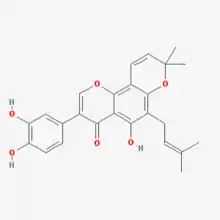 | |
| Names | |
|---|---|
| IUPAC name
3′,4′,5-Trihydroxy-6′′,6′′-dimethyl-6-(3-methylbut-2-en-1-yl)-6′′H-pyrano[2′′,3′′:7,8]isoflavone | |
| Systematic IUPAC name
3-(3,4-Dihydroxyphenyl)-5-hydroxy-8,8-dimethyl-6-(3-methylbut-2-en-1-yl)-4H,8H-(benzo[1,2-b:3,4-b′]dipyran)-4-one | |
| Other names
Pomiferin | |
| Identifiers | |
3D model (JSmol) |
|
| ChemSpider | |
PubChem CID |
|
| UNII | |
CompTox Dashboard (EPA) |
|
| |
| |
| Properties | |
| C25H24O6 | |
| Molar mass | 420.45446 g/mol |
| Density | 1.314g/cm3 |
| Boiling point | 673.5°C at 760 mmHg |
| DMSO, Acetone | |
| Hazards | |
| Flash point | 233.3°C |
Except where otherwise noted, data are given for materials in their standard state (at 25 °C [77 °F], 100 kPa).
Infobox references | |
Pomiferin is a prenylated isoflavone that can be found along with osajin in the fruits and female flowers of the osage orange tree (Maclura pomifera).[1]
Pomiferin was identified and named in 1939 by Melville L. Wolfrom from Ohio State University.[2] In 1941, Wolfram classified pomiferin as an isoflavone and in 1946 published the complete structure of Pomiferin.[3] In 2003 the crystal structure of pomiferin (3-(3,4-dihydroxyphenyl)-5-hydroxy-8,8-dimethyl-6-(3-methylbut-2-enyl)-4H,8H-pyrano[2,3-h]chromen-4-one), C25H24O6 was reported by J. Marek.[4]
In recent research Pomiferin has demonstrated efficacy as an antioxidant, cardioprotectant, antimicrobial, antidiabetic, PDE5 inhibitor and cytotoxicity for several cancer cell lines.
Research
Repellent
Peterson and Fristad (2000) investigated folklore beliefs stating that osage orange fruit repelled insects. They concluded that pure pomiferin had little or no effect and that there must be another component of the Osage orange that repels insects.[5]
Antioxidant
Pomiferin has shown antioxidant activity via inhibition of lipid peroxidation and the reduction of free radicals, reactive oxygen species and other unstable molecules. Tsao and Yang (2003)[6] reported that Pomiferin was found to be a strong antioxidant, comparable to the vitamins C and E and the synthetic antioxidant BHT.[7]
Cardioprotectant
Necas and Bartosíková (2007) reported that the chemical had potent cardioprotective effect on rat hearts subjected to ischemia and reperfusion injury. The mechanism for this protection may occur through the inhibition of lipid peroxidation.[8]
Antimicrobial
Mahmoud (1981)[9] indicated that pomiferin exhibited antibacterial activity against E. coli and Salmonella gallinarum, as well as Mycobacterium smegmatis to a lesser extent.
Antidiabetic
Bartosíková and Necas (2007), furthermore, conducted a biochemical examination showing antioxidative and antidiabetic effects of pomiferin.[10]
Moon (2014) presented results of a study that evaluated the antidiabetic effect of osajin and pomiferin from the Osage orange in normal and streptozotocin-induced diabetic rats. Pomiferin in the streptozotocin-induced diabetic rats resulted in significant hypoglycemic activity for 14 days following, by decreased the serum glucose and triglycerides while increasing serum insulin in those rats.[11]
PDE5 inhibitor
Ribaudo (2015)[12] proposed pomiferin and osajin as potential lead compounds for the development, starting from natural scaffolds, of a new class of PDE-5A inhibitors with vasorelaxant properties to treat pulmonary hypertension and erectile dysfunction.
Anti-cancer activity
Svasti (2005)[13] observed that pomiferin induced apoptosis and differentiation in cholangiocarcinoma cell line HuCCA-1.
Son (2007)[14] investigated the growth-inhibitory activity of pomiferin compared to SAHA (suberoylanilide hydroxamic acid). Pomiferin exhibited cytotoxicity effects on six cancer cells lines: Kidney (ACHN), Lung (NCI-H23), Prostate (PC-3), Breast (MDA-MB-231), Melanoma (LOX-IMVI) and Colon (HCT-15).
References
- ↑ Orhan, I (2009). "Cholinesterase inhibitory effects of the extracts and compounds of Maclura pomifera (Rafin.) Schneider". Food and Chemical Toxicology. 47 (8): 1747–51. doi:10.1016/j.fct.2009.04.023. PMID 19394400.
- ↑ Wolfrom, Melville (1939). "Isolation of a New Pigment, Pomiferin" (PDF). J. Am. Chem. Soc. 61 (10): 2832–2836. doi:10.1021/ja01265a079. Retrieved 9 August 2015.
- ↑ Wolfrom, Melville (1946). ". Complete Structures of Osajin and Pomiferin" (PDF). J. Am. Chem. Soc. 68 (3): 406–418. doi:10.1021/ja01207a021. PMID 21015734. Retrieved 9 August 2015.
- ↑ Marek, J; Veselá, D; Lisková, M; Zemlicka, M (2003). "Pomiferin". Acta Crystallogr C. 59 (Pt 3): o127–8. doi:10.1107/s0108270103002300. PMID 12711784.
- ↑ Peterson, Chris (1 December 2000). "Osajin and Pomiferin, Two Isoflavones Purified from Osage Orange Fruits, Tested for Repellency to the Maize Weevil (Coleoptera: Curculionidae)". Environmental Entomology. 29 (6): 1133–1137. doi:10.1603/0046-225X-29.6.1133. S2CID 4889925.
- ↑ Tsao, Rong (2003). "Antioxidant Isoflavones in Osage Orange, Maclura pomifera (Raf.) Schneid". Journal of Agricultural and Food Chemistry. 51 (22): 6445–6451. doi:10.1021/jf0342369. PMID 14558760.
- ↑ Schall, E.D. (1956). "The antioxidants of the osage orange fruit". J. Am. Oil Chem. Soc. 33 (2): 80–82. doi:10.1007/BF02612556. S2CID 85143867. Retrieved 15 August 2015.
- ↑ J. Nečas, J. (2007). "Protective Effects of Flavonoid Pomiferin on Heart Ischemia-Reperfusion". Acta Vet. Brno. 76 (3): 363–370. doi:10.2754/avb200776030363.
- ↑ Mahmoud, F.Z. (1981). "Antimicrobial components from Maclura pomifera fruit". Planta Med. 42 (3): 299–301. doi:10.1055/s-2007-971646. PMID 7280089.
- ↑ Bartosíková, L (2007). "Examination of the antioxidative and antidiabetic effect of pomiferin in alloxan-induced diabetes mellitus in". Ceska Slov Farm. 56 (3): 135–40. PMID 17867526.
- ↑ Moon, H. I. (2014). "Effect of osajin and pomiferin on antidiabetic effects from normal and streptozotocin-induced diabetic rats". Nat Prod Commun. 9 (12): 1723–4. PMID 25632468.
- ↑ Ribaudo, G. (2015). "Semi-synthetic derivatives of natural isoflavones from Maclura pomifera as a novel class of PDE-5A inhibitors". Fitoterapia. 105: 132–138. doi:10.1016/j.fitote.2015.06.020. PMID 26136059.
- ↑ Svasti, J. (2005). "Proteomic profiling of cholangiocarcinoma cell line treated with pomiferin from Derris malaccensis". Proteomics. 5 (17): 4504–9. doi:10.1002/pmic.200401315. PMID 16220529. S2CID 38899441.
- ↑ Son, Il Hong. "Pomiferin, histone deacetylase inhibitor isolated from the fruits of Maclura pomifera" (PDF). personal.evangel.edu. Retrieved 22 August 2015.
Further reading
- Son, Il Hong; et al. (2007). "Pomiferin, histone deacetylase inhibitor isolated from the fruits of Maclura pomifera". Bioorganic & Medicinal Chemistry Letters. 17 (17): 4753–4755. doi:10.1016/j.bmcl.2007.06.060. PMID 17662606.
- Svasti, Jisnuson; et al. (2005). "Proteomic profiling of cholangiocarcinoma cell line treated with pomiferin from Derris malaccensis". Proteomics. 5 (17): 4504–4509. doi:10.1002/pmic.200401315. PMID 16220529. S2CID 38899441.
- Veselá, Dagmar; et al. (2004). "Antioxidative and EROD activities of osajin and pomiferin". Fitoterapia. 75 (2): 209–211. doi:10.1016/j.fitote.2003.12.005. PMID 15030927.
- Marek, Jaromir; et al. (2003). "Pomiferin". Acta Crystallographica Section C. 59 (3): 127–128. doi:10.1107/S0108270103002300. PMID 12711784.